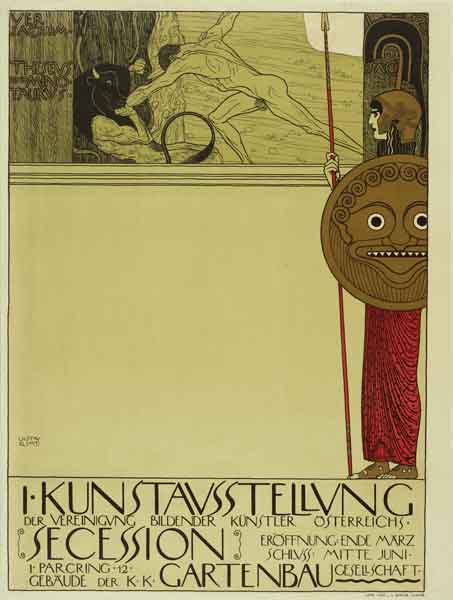Klimt and the Vienna Secession
1897-1905
The foundation of the Vienna Secession is considered a milestone for the artistic renewal of “Vienna 1900” and the birth of Viennese Jugendstil. 23 artists, above all Gustav Klimt, Josef Hoffmann, Joseph Maria Olbrich, Kolo Moser and Carl Moll, dissatisfied with the exhibition politics of the time and encouraged by the foundation of secessionist movements in Paris and Munich, left the hitherto predominant “Genossenschaft bildender Künstler Wiens” at the Künstlerhaus artistically shaped by Hans Makart to form the “Vereinigung bildender Künstler Österreichs – Secession”. Secessio means separation and stands for the rejection of historic, academic traditions. Artistically, the secessionist artists oriented themselves by international Modernity. Symbolist and strictly formal aspirations, the tendency towards flat compositions and influences from the Far East were essential characteristics of this new “Style Art”.
Gustav Klimt was the first president of the association and designed a blueprint for the exhibition building himself [1]. He also conceived the poster for the first exhibition in 1898, which depicts – observed by Athena, the goddess of the arts – the young Theseus fighting the Minotaur, symbolising the conflict between the Secession and the historic burden of tradition. Due to the almost completely naked Theseus, the poster was censored by the state and Klimt had to “conceal” it with scattered trees [4]. At the end of 1898 the building, which was finally erected by Joseph Maria Olbrich in a prominent location close to the Naschmarkt, was inaugurated and is still fondly called the “Krauthappel” (“Cabbage”) by the Viennese today. Over a white, temple-like cube towers a majestic dome with over 3,000 gilded bay leaves. A quote by the art critic Ludwig Hevesi – “To the age its art. To art its freedom” – became the slogan of the Vienna Secession and decorates its entrance portal [2-3].
Between 1897 and 1905 the Secession organised 23 groundbreaking exhibitions and it was thanks to the Secession that one could see the contemporary European art of the time, including works by Cézanne, Monet, van Gogh, Rodin, Munch and Hodler, in Vienna. The exhibitions were accompanied by artistically outstanding posters, exceptionally designed catalogues and an interior that, with its clear, geometric lines, appears extraordinarily modern even today [5-6]. The journal “Ver Sacrum” (“Sacred Spring”) was published regularly between 1898 and 1903, with graphic design playing a major role alongside contributions from art and literature. The members of the Secession submitted frontispieces and decorative designs [7]. After internal controversies regarding the orientation of the Secession, Gustav Klimt left the association in spring 1905 with the so-called “Klimt group”. Without him, the illustrious exhibition series was not able to continue.








